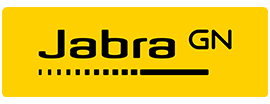























£6,001.30*
£8.99
- Resolution 1920 x 1200 WUXGA
- Field of view 180°
- wireless technology AirPlay, Bluetooth


Frequently purchased together
Product information
PanaCast 50 VBS ZR is now available as an all-in-one video bar room system - with intelligent AI experience as well as an integrated computer for an easy-to-use meeting room solution that engages all participants.
Jabra has developed the intelligent camera features for leading online meeting platforms to provide a great user experience for all participants, where everyone is equally motivated and involved. With easy implementation and intuitive use, teams can come in and get started right away.
Experience the following highlights:
- Impressive sound
- Perfect 180° panoramic view in 4K resolution
- Integrated AI Enables a range of intelligent features
- Complete system Includes everything you need for your meeting
Encompassing meetings that include all participants - really all
Nearly half of hybrid workers feel left out when they are not in the meeting room. Thanks to the intelligent features of the PanaCast 50, the video bar system is the complete solution for more productive meetings that include all participants. When the whole team can share on an equal footing, it leads to better results.

Sound quality that inspires.
For successful meetings, you need perfect sound. As the world leader in professional sound technology, Jabra knows best.
With eight professional microphones and high-precision voice detection, Jabra has redefined meeting room sound for the way people work today. Intelligent algorithms automatically detect and filter echoes and noise. Four powerful speakers deliver premium high-definition (HD) stereo sound throughout the room. In addition, Jabra has built them in a vibration-neutralising arrangement.

Hearing and being heard, naturally.
Meetings are more successful when everyone can communicate clearly. Advanced beamforming technology optimises the signal-to-noise ratio for clearly intelligible voices throughout the room. Advanced full-duplex technology also ensures that everyone can join the conversation in real time at all times. Even short interjections, so important in face-to-face conversations, remain easily intelligible.

Everyone(s) in the picture.
In addition to world-leading sound technology, you now get video technology that keeps everyone in the picture. The high-precision multi-camera array with three 13-megapixel cameras covers the entire room. Best of all: Patented real-time stitching technology automatically stitches the three video feeds together live to create a continuous 180° panoramic view in 4K resolution. Enjoy a distortion-free picture of all participants with no one missing. The Jabra PanaCast 50 enables comprehensive meetings for everyone.

Get in and get started
There's nothing like a consistent and simple system. That's why Jabra designed the PanaCast 50 video bar system so you don't have to connect your laptop or untangle cables. Start your next meeting with the touch of a button - wireless content sharing puts everything you need right at your fingertips.
Instant. Comprehensive. Human.
Are you looking for a video conferencing tool that automatically recognises speakers and intelligently crops the image accordingly? The powerful Edge AI processor chips use specially developed algorithms to intuitively follow the course of the meeting. They automatically adjust the image section in real time and focus on the person speaking. The result is a meeting experience that focuses on the important content and ensures that all participants hear everything.
Keep everything in view.
The PanaCast 50 ensures that the specifications for the maximum number of people are adhered to. Our intuitive software anonymously counts how many people are present and provides analysis/insights on room occupancy. Captured via the unique 180° data stream, it provides real-time data on the number of people even if the video stream only shows a specific person or area. Using Jabra Xpress visual data, you can analyse past meetings and make data-driven decisions.
And the best part? This feature doesn't require a connection to a computer, so you can even capture impromptu meetings.
Scope of delivery:
- PanaCast 50 VBS Base Unit
- Power Supply
- Wall Mount
- Screen Cover with Sensor
- Cable Compartment Cover and Tools
- Jabra PanaCast Control, PoE power injector
- 1 x Ethernet cable (1.83 m)
- 2 x Ethernet cable (4.57 m)
- 1 x HDMI cable (1.83 m)
- 2 x regional power cable
Technical data
| Name | Jabra 50 VBS Video conferencing system, 1920 x 1200 WUXGA, 13 MP, 180° |
|---|---|
| Article number | 1000028982 |
| GTIN/EAN | 5706991027945 |
| Manufacturer SKU | 8502-231 |
| Model name | 50 VBS |
| Brand | Jabra |
| Product Type | Video conferencing system |
| Resolution | 1920 x 1200 WUXGA |
| Camera resolution | 13 MP |
| Field of view | 180° |
| Inputs | 1x HDMI |
| wireless technology | AirPlay , Bluetooth |
| Features | Microsoft Teams , Zoom |
| Product width | 73 cm |
| Product height | 7.7 cm |
| Product depth | 14.6 cm |
| Weight | 23.7 kg |
| Colour | Black |
| Delivery contents | Ethernet cable , HDMI Cable , Power cable , mount |
| Condition | New |
| Warranty type | Bringin service Service and support information |
Product safety
| Person responsible for the EU |
|---|
| GN Audio A/S |
| Lautrupbjerg 7 |
| 2750 Ballerup |
| Denmark |
| support@jabra.com |






